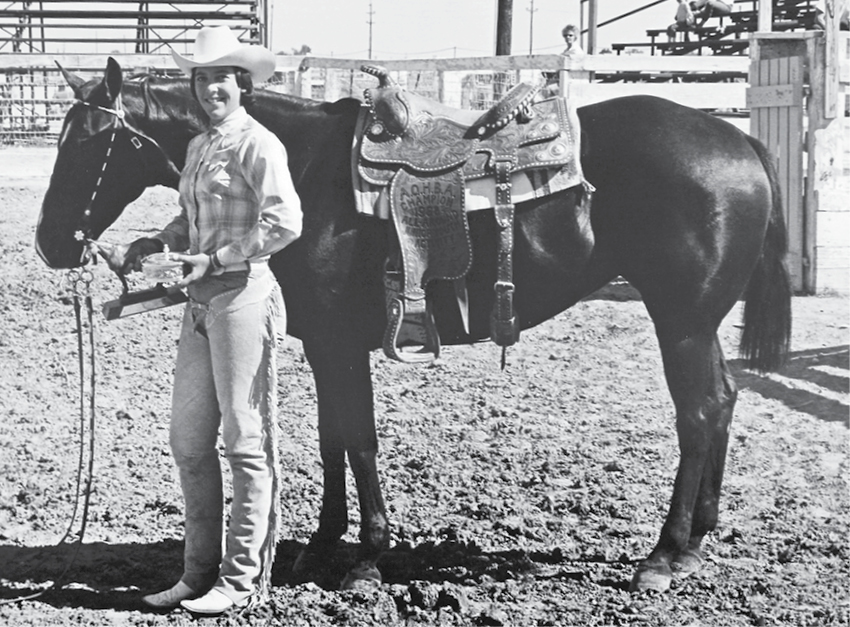
My first event, at just 6 years of age, was the local county 4-H show. Roanie, my mount, was a big, unregistered ranch horse, with a head the size of a fishing boat and the scars of living and working on the ranch all over his blue-roan hide.
[MORE ABOUT: LAUREL DENTON]
We were a team, though, and devoted to each other. Roanie took his job—taking good care of me—seriously. Together we gathered cattle on the short days, and I learned to lope in a circle (probably not on the correct lead). Our first class was unregistered aged geldings at halter; other classes followed, and Roanie wound up the Reserve Champion Unregistered Horse of the show.
As we left the ring with that purple-and-white ribbon, I understood about pride of ownership for the first time. My parents, by contrast, understood it was time for me to get some lessons with a professional and perhaps start looking for another horse. The American Quarter Horse Association was talking about a new youth division, and the show world was advancing. Still, I have humble Roanie, as much as any horse that came after him, to thank for sparking the passion for knowledge that led to my accomplishments over the years.
My parents were on the ground floor of Quarter Horse racing in Arizona in the 1950s and ’60s. Their Bar U Bar Ranch was the owner and breeder of several AAA AQHA champions, which was big deal back then. As a youth, I got to show some ex-racehorses, an experience invaluable for learning to recognize form to function and the importance of training according to a horse’s personality type.
One of those memorable horses was Smoke Eye, an all-black mare with a blue eye. During her retraining for the show pen, she was high-energy and busy-minded, and I soon learned she needed to get some confidence in the different disciplines. I had her in different bits for horsemanship, reining, and Western riding. I don’t think she could decipher which class she was going in because of the bit, but I do believe the different bits enabled me to communicate my commands more effectively.
Smoke Eye earned her AQHA and AQHYA (Youth) championships and was a prime example of how hard work and consistency pay off. She taught me that lesson early, and I’m still teaching it to my students and at my clinics today.
Self-discipline is also essential. Horses are one of the most intuitive animals on the planet. They can tell if you’re having a bad day or even just not paying attention, and they’ll follow where your eyes take them. A horse can feel what the rider is thinking!
For this reason, I never tire of watching a horse’s expression while I’m giving a lesson, as it often tells me what the rider is doing wrong or right. Some students think I’m reading their minds.
“Why were you worried about stopping in the middle of the arena when you were going all the way to the end?” Yes, your horse told me that!
Just as horses can read our minds, it’s our job to try to understand precisely what they’re telling us. You must keep your horse interested and advancing in his training, even if you have no plans or desire to be in the show ring. Advancing to a higher level of proficiency with your horse should always be your goal.
Horses crave a leader and will show their appreciation with their performance. At a recent clinic, I reprimanded a rider for letting her horse graze during the ranch trail portion. As riders waited their turn to go on the obstacles, her horse was grabbing a snack. I explained that a horse doesn’t have the reasoning power to understand why he’ll be in trouble if he stops and grazes while on the course—yet it’s OK for him to graze 30 feet away. This is part of being a better rider and forming a consistent partnership with your horse.
Whether you’re running barrels, working a cow, showing in ranch riding, or just enjoying the trails, now is the time to step up and form that special partnership with your horse. Enroll in a clinic, read some of the great books by horsemen, or ask a professional for his or her opinion.
Keep your eyes on the prize—which is simply becoming a better partner and horseman. You’ll never regret it.
[MORE WITH LAUREL: RANCH RIDING PRESENTATION]




